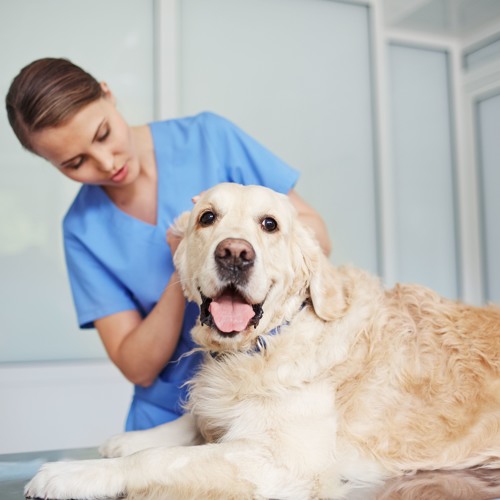
Sponsored by Zoetis Petcare.

Sponsored by Vetoquinol.
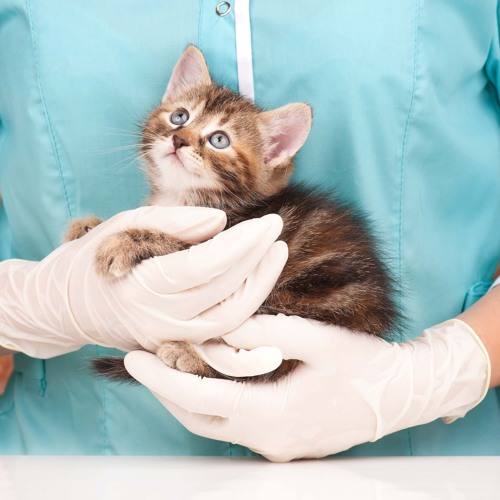

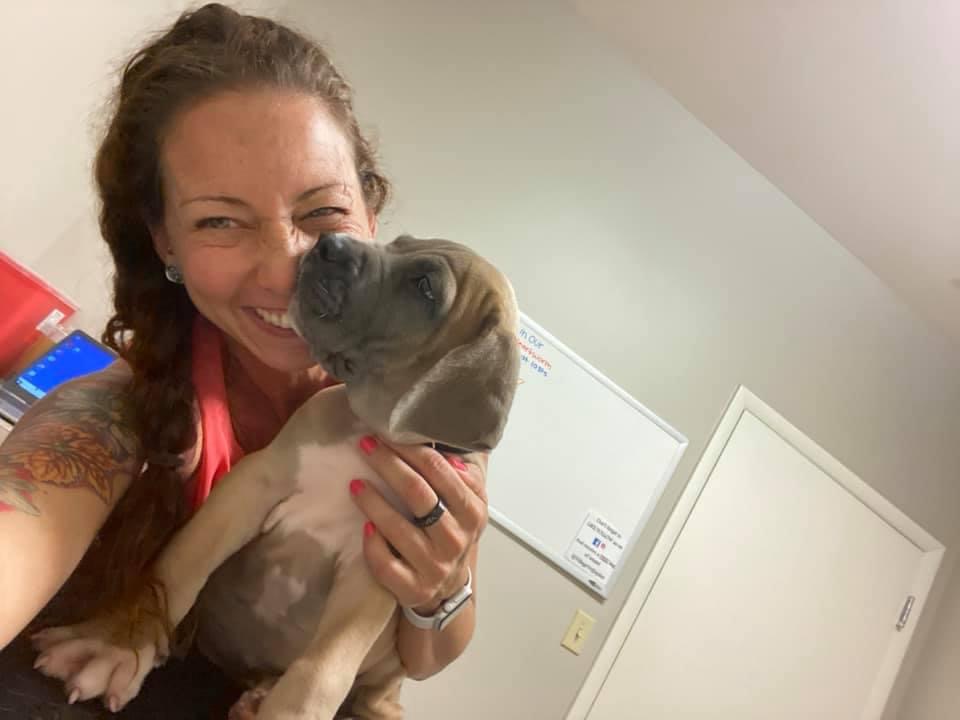
When she was 12 years old, Karina Salvo, DVM, CTPEP, CVFT, CVMMP, volunteered to work for a one-doctor practice. Cleaning cages, doing laundry, and walking dogs led to watching her first surgeries. From that point, she knew that her career path would lead to veterinary school.
But one thing she and the veterinarians she grew up working for—and later, with—didn’t learn was how to make exams easier on pets. When she became aware of Fear Free®, though, it made sense to her that veterinary visits should be less frightening and more fun for patients.—not to mention for veterinarians and technicians themselves.
“The one thing that I noticed in each and every practice was the frequency in using force to hold a patient,” says Salvo, now an Elite Fear Free Certified® DVM who also has certifications as a palliative and end-of-life practitioner (CTPEP) and in branches of Traditional Chinese Medicine (CVFT and CVMMP). “Some of the staff wrestled what I thought were highly aggressive dogs down to the ground in order to give a single vaccine or draw blood. The end result was someone got hurt, scratched, urine and feces everywhere, and a dog that was left splayed out and panting on the floor in exhaustion or cowering in the corner. This was the ambience of the veterinary field I grew up in.”
As she learned more from Fear Free, she found that in-clinic exams became easier.
Now she owns her own practice, AcuVetDoc Veterinary Reproduction & Animal Care Wellness Clinic, in Royal Palm Beach, Florida, where she treats not only pets but also wildlife. That allows her to see only one patient at a time.
“I can practice 100 percent the way I choose to. I intentionally do not have a receptionist or a technician,” Salvo says. “Patients are scheduled on the hour instead of every 15 minutes. This allows me to work one on one with the patient and the owner. My ‘team’ in my practice is the owner, myself, and the patient. By working together, all of us can better understand the patient and the medicine. Practicing this way has allowed me to build trust in my patients as well as owners because both are comfortable.”
Salvo greets clients and patients at the door so she can watch how the animal walks into the building. If owners have given permission beforehand, treats are on the carpeted floor as they enter.
Animals who have previously had poor experiences at veterinary clinics may be directed into an exam room that resembles a living room—with carpet, a bookcase, leather sofa, chair, and hidden treats. While Salvo sits on the floor, pockets filled with treats, and talks to the owner, patients can explore, approaching when they’re comfortable. If they need more time, Salvo may simply hand out treats during the visit, holding off on an exam. She discusses this possibility with clients beforehand so that they’re aware the first interaction may be a “meet-and-greet,” with the exam portion on a subsequent visit.
Many of her patients enjoy “playtime,” a rewarding exam in which Salvo uses tasty treats to get patients to move on their own but in a fashion that allows her to examine them. For instance, she might get them to sit or turn their head so she can look inside ears or examine the mouth.
One patient who stands out in her memory was a 12-week-old Cockapoo puppy whose first experience at a veterinary clinic had involved being held on an exam table while he screamed, attempted to bite, and urinated and defecated. The veterinarian told the owners that their puppy had mental health issues and should be returned to the breeder. This time they were hoping for a better experience.
Salvo met the owners outdoors, where she had set up chairs and some treats. They sat down, talked about how the puppy was doing at home, and handed out treats to the puppy. Salvo assigned homework: to find tasty, high-value treats that could be dropped on the floor any time visitors came to the home and to be used as rewards during training. She suggested walking the puppy in areas far enough away from people that strangers wouldn’t want to pet the dog but close enough that he could see people, other dogs, and vehicles such as carts. Offering high-value treats during these walks would contribute to forming a positive association with the experience and a connection with the owners.
At the second visit a few days later, Salvo again met the owners outside and had tasty treats already on the ground for her new friend to gobble up. Eventually, the puppy approached her and she was able to perform an exam and give an oral vaccine as the puppy sat next to the clients and received treats.
“On subsequent visits, we sat next to each other outside, and he came and laid on my lap and became more interactive with me and less afraid of the environment,” says Salvo. “With a cheese and Cheerio trail to lead him inside, we made it to the scale and an exam room!”
Three months after that first visit, the puppy frequents farm fairs, Home Depot, and PetSmart, and comes running into the clinic to greet Salvo.
“This is an amazing story with very patient owners who were willing to take their time to understand and provide their dog with what he specifically needed when he needed it, redirection to something positive, protection from being thrown into the middle of a chaotic situation, and to slow introduction to the world around him,” she says.
Fear Free continues to make a difference in her practice. “The best feeling is when the owners are ready to leave and the patient stays behind and makes eye contact with me waiting for another fun treat,” Salvo says, “or when they return and they are pulling their owner into the building.”
This article was reviewed/edited by board-certified veterinary behaviorist Dr. Kenneth Martin and/or veterinary technician specialist in behavior Debbie Martin, LVT.
Sandra Toney has been writing about cats for over 25 years and is an award-winning member of Cat Writers Association and Dog Writers Association of America. She has written for many print and online magazines about cat health and behavior as well as authoring eight books. She lives in northern Indiana with her cat, Angel.
Want to learn more about Fear Free? Sign up for our newsletter to stay in the loop on upcoming events, specials, courses, and more by clicking here.
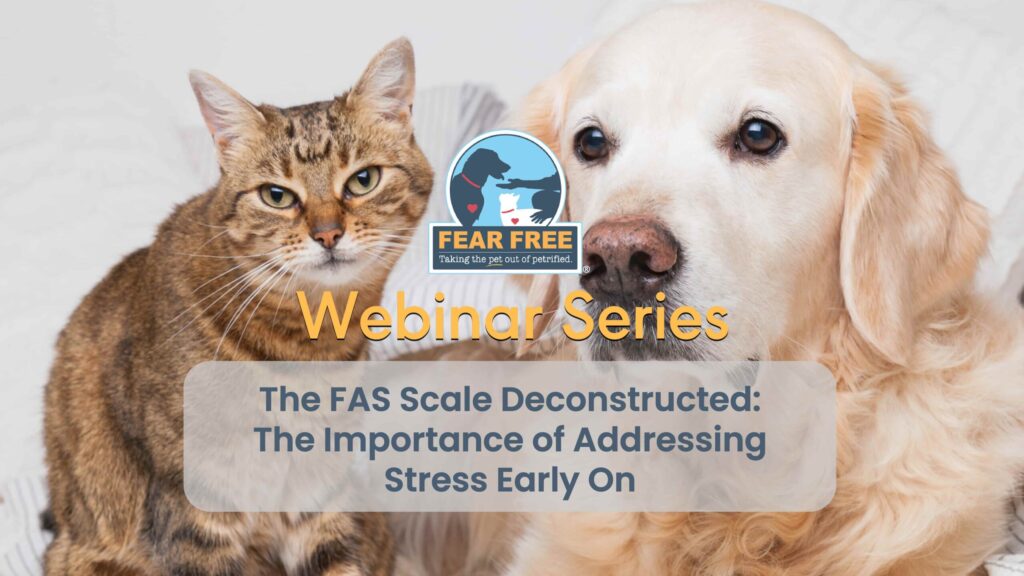
The FAS Scale Deconstructed: The Importance of Addressing Stress Early On
In this recorded webinar, Fear Free’s Education Manager Lori Chamberland takes a closer look at each level of the FAS scale to empower you to score pets with greater confidence. You’ll see video examples of pets at each level of the scale and understand why it’s important to address stress early, rather than waiting until FAS 3 or higher to intervene.
You must be a Fear Free member and logged in to view this webinar.
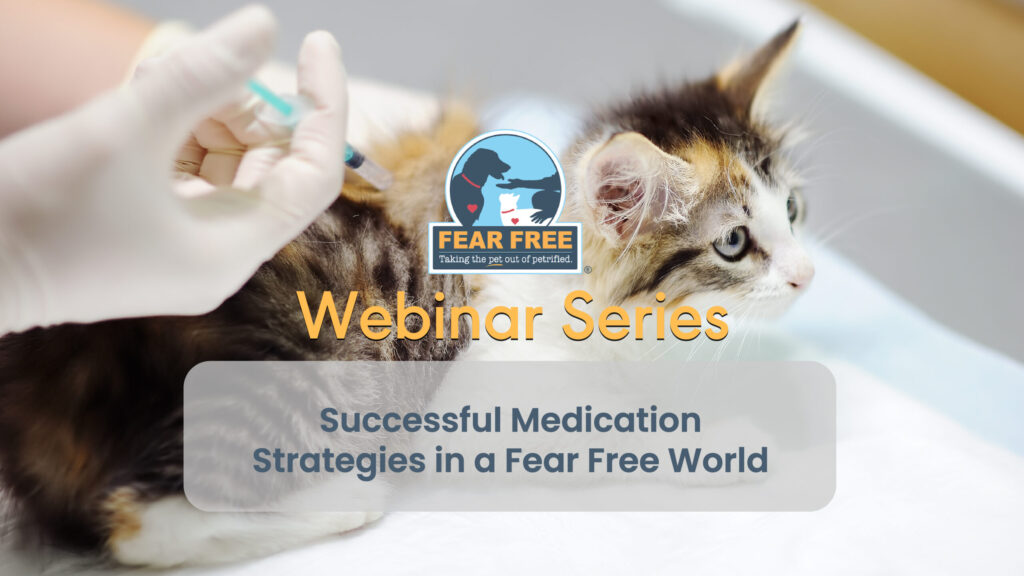
Successful Medication Strategies in a Fear Free World
In this recorded webinar, Sharon Minninger, DVM, discusses how we can modify our thoughts and actions to improve the “just medicate my pet” problem. She also addresses what other medication forms can be considered and how to develop strategies to train your team and your clients for success.
Brought to you by our friends at Covetrus

Course Overview
In this one-hour course, you’ll learn about the different types of stress and how stress impacts the brain. You will develop an understanding of learned helplessness, the range of behaviors commonly associated with toxic stress, and the connection between those behaviors and changes to the brain. The course will finish with a discussion of the benefits of giving an animal more control and how that changes the brain. By the end of this course, you should have a strong understanding of why Fear Free principles are important for promoting both physical and behavioral health and wellbeing.
This course contains four lessons:
This course was written by Kristina Spaulding, PhD, CAAB and is approved for one hour of RACE CE.
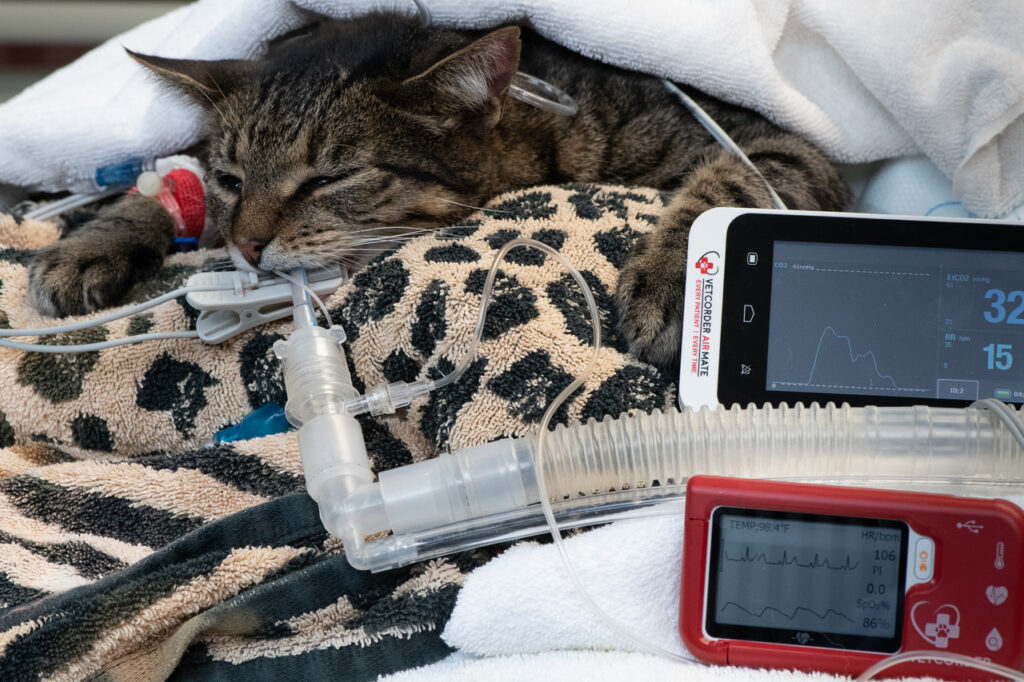
Wouldn’t it be wonderful if you could approach dentistry without fear, anxiety, or stress? It can be done and it’s not all that difficult. Let’s dissect the touchpoints of dental fear and how to replace dread with confidence.
Client Fear
1. Fear of Anesthesia
This is generally your client’s number-one trepidation. Fortunately, modern, safe anesthesia procedures include (1) evaluating the patient with physical and laboratory exam beforehand, (2) tailoring medication protocols to the patient, and (3) constant monitoring while anesthetized and during post-anesthesia recovery. Sharing these safety measures with your clients goes a long way to alleviate their fear.
2. Fear of Tooth Loss
Often clients will ask “How will my dog eat if you extract so many teeth?” The reply should be “Better than ever before because by removing the diseased teeth, the mouth will now be pain-free.”
3. Fear of Expense
This concern is often shared by both the client and veterinarian. To mitigate this fear, concentrate on what needs to be done to provide the pet with a pain-free, healthy, “happy” mouth. When asked “What is this going to cost?” early in the exam, answer that you will discuss fees “before we leave this room” and “cost is going to be part of the good news.” This can help set the client’s mind at ease and allow them to focus on their pet, the exam you’re performing, and the expertise you’re sharing. Once you’ve established an optimum treatment plan, you can work together to find the best way to make it happen, including payment.
Keep in mind that clients are used to going to their own dentist and are familiar with dental costs. Fortunately, most veterinary practices offer financing, such as the CareCredit healthcare credit card, as a payment option. This allows clients to pay for their pet’s dental care over time in budget-friendly monthly payments rather than the entire cost upfront.
Functional vs. Optimal Care
There are bound to be challenges on the path from the basic dental care to optimum care. Most clients want to do the very best for their pet, but cost and time commitment with after care can be barriers. Our job is to provide them with solutions that make the best care possible—budget-wise, time-wise, and health-wise.

Root planing, local antimicrobial administration (LAA), and laser periodontal surgery are often recommended for optimum care, but these simply may not be in the financial comfort range of some clients. This is where payment options can help to pay for the care they want for their pet or they can choose functional care.
Some pet owners may be unable or unwilling to provide needed follow-up care. In these cases, multiple extractions are usually necessary to create a pain-free, functional mouth. It may not be gold standard, but the pet will receive great basic care that supports quality of life.
Perhaps the most important thing to remember is that moving clients from fear to acceptance for their pet’s dental care is possible when we take the time to communicate the value and not just the cost.
Veterinary Fears
1. Oral Surgery
While the goal in veterinary dentistry is to save teeth, it often becomes necessary to remove some or all of the teeth. Indications for extractions include fractured teeth, advanced periodontal disease, non-functional orthodontic disease, and chronic ulcerative conditions. Oral surgery fears include excessive bleeding, inability to remove the entire tooth, jaw separation, and dehiscence. Fortunately, these worries are easy to change into happy opportunities.
- Excessive bleeding can be mitigated through avoidance, realizing that in the maxilla the most troublesome area surrounds the infraorbital artery, which exits the infraorbital canal just above the maxillary third premolar. In the mandibles the area to avoid is the mandibular canal. When either of these are breached, bleeding occurs, which can be minimized by elevating the head with towels, applying a hemostatic agent (Vetigel®), and gauze pressure.
- Inability to remove the entire tooth through root separation can usually be prevented by examining intraoral radiographs before the procedure, large exposure, and gentle luxation with a sharpened luxating elevator.
- Jaw separation, occurring usually secondary to advanced periodontal disease, is rare. Consultation with a veterinary dentist is recommended.
- Dehiscence is also rare and, in most cases, should be left alone to self-heal.
2. Not enough time
This proven workflow can eliminate time fears.
A client calls to schedule a teeth-cleaning visit due to oral malodor. The client care coordinator shares that your practice provides more than teeth cleaning. The client will be scheduling an appointment for oral prevention, assessment, and treatment (Oral PAT). This is the time to be sure clients understand the value of complete oral care:
- There is a dental cause for their pet’s halitosis.
- This will be diagnosed during the initial oral examination, pre-anesthesia testing, as well as a tooth-by-tooth examination under general anesthesia.
- Recommended treatment for the cause will be discussed, and it can be performed during the same anesthesia, time permitting, or at a later time.
- The doctor will make plaque and tartar control suggestions the client can perform at home to support overall oral health.
Here’s a timeline example…
9 a.m. The owner brings their dog or cat into the exam room. Review the history and previous laboratory results, examine the pet, and focus on the oral cavity. Discuss owner willingness and ability to provide daily plaque control. Share the value of the services, then discuss fees for initial diagnostics and dental scaling and radiograph imaging before the client leaves the exam room. The client agrees in writing that they understand:
- Anesthesia will be performed, and they have been informed of the associated risks.
- There will be additional fees if extra care is needed to treat the cause of the malodor.
- Payment options are discussed openly.
Next, inform the client what to expect from the day and arranges a time (1 p.m.) to speak to the owner while the pet is still anesthetized after the cause of halitosis has been determined.
9:30 – 11 a.m. The staff acquire pre-anesthetic test results to share with the veterinarian and prepare the patient for anesthesia.
11:30 a.m. – 12:45 p.m. The patient is anesthetized, teeth are cleaned, intraoral radiographs are exposed and placed in a template for the veterinarian to examine chairside. The veterinarian is handed a dental probe to conduct the tooth-by-tooth examination and treatment plan, dictating results to an assistant who creates the dental chart. The assistant tabulates additional fees and creates a report or takes cell phone images, which are emailed to the client.
1 p.m. Talk to the pet owner to review what was found and describe optimum treatment and why it is important for their pet. Fees for the additional care are discussed, along with payment options.
3 p.m. Therapy (e.g., extraction of multiple teeth and application of a locally applied antimicrobial to stop bleeding on probing points) is completed.

5:30 p.m. The client meets with the doctor to review the diagnostics and therapy. A follow-up appointment is set to evaluate healing and create a daily plaque prevention program tailored for the pet.
3. Proper Assistance, Equipment & Instruments
An assistant goes far to lessen the load on the veterinarian during dental treatment.
Proper instruments and equipment are also important:
Elevators: Because there are a variety of sizes of teeth, one needs a variety of sizes of dental elevators. Generally, select the elevator that best fits the contour of the tooth to be extracted. The Heidbrink and Miltex 76 are root tip picks useful in elevation and for extracting retained root tips. They also can be used to cut the gingival attachment off the tooth prior to displacement with dental elevators.
Extraction Forceps: Smaller extraction forceps have been designed for dog and cat teeth. They have more parallel jaws, increasing the surface contact and are much more effective than the human incisor forceps formerly used in veterinary dentistry.
Magnification & Lighting: One frustrating aspect of oral surgery is the limited access and poor visibility. These problems may be decreased using magnification (2.5-3 power) and head lamps.
Sterilization of Equipment: Since extraction is a surgical procedure and the instrument penetrates tissue sterile instruments should be used. While it is true that the tissue surrounding the tooth is already infected, it is inappropriate to add different species of bacteria to the infection. Chemical disinfectants may be effective, but they take time to work, and must be thoroughly washed off prior to use.
Hemostatic Agent: Vetigel® is used to syringe over a bleeding area. Within a minute the bleeding generally stops.
Flaps: Surgical extractions are performed by making releasing incisions on the mesiobuccal and distobuccal line angles between adjacent teeth. These releasing incisions are joined by an intrasulcular incision that follows the gingival margin. The periosteum and gingiva are elevated off the bone with a periosteal elevator, to create a full-thickness gingival flap. The buccal plate of bone over the tooth is removed with a water-cooled high-speed bur. The root is removed, and the flap is closed without tension over the alveolar socket.
Postop
Radiographs taken postoperatively allow the practitioner to verify that the entire tooth has been extracted. Radiographs create a permanent record of the procedure. The possible pain to the patient caused by the disease condition or the procedure creates the need for consideration of pain medication administered by injection of a local anesthetic, parenteral injection, and oral pain relief medication.
Complications
- Tooth roots may become separated during the extraction procedure, creating non-extracted root fragments. The preferred treatment in this situation is to create a buccal flap over the fragment for removal.
- Collateral damage to other oral or extra oral structures including perforation and orbital contusion of the eye with sharp dental instruments.
Using proper instrumentation and extraction technique makes the extraction simpler, safer, and easier on the patient and practitioner. Multirooted teeth should always be sectioned prior to extraction to prevent the likely hood of fractured root segments. Difficult extractions can be accomplished by gingival flap surgery to facilitate atraumatic elevation of the root in a buccal direction. Pre- and postoperative radiographs and pain control help document what has been done and provide the patient with a relatively painless procedure.
Pet Fears
Let’s not leave out the patient, who is our most important consideration. Fear Free practices such as use of nonslip surfaces and techniques such as considerate approach and touch gradient contribute to the success of dental procedures.
Creating a Fear Free dental practice is achievable. I am always happy to help. Please email any questions (dentalvet@aol.com) or call on my cell 954-465-4200.
References
- DeBowes LJ. Simple and surgical exodontia.Vet Clin Small Anim 2005; 35:963–984.
- Gunew M, Marshall R, Lui M, Astley C. Fatal venous air embolism in a cat undergoing dental extractions.J Small Anim Pract2008; 49, 601–604.
- Holmstrom SE, Frost, P, Eisner ER. Exodontics. In:Veterinary Dental Techniques for the Small Animal Practitioner. 3rd ed. Philadelphia: Saunders, 2004, pp. 291–338.
- Kapatkin AS, Manfra Marretta S, Schloss AJ. Problems associated with basic oral surgical techniques. In:Problems in Veterinary Medicine. Dentistry. Manfra Marretta S ed., 1990; 2: 85–109.
- Reiter AM, Brady CA, Harvey CE. Local and systemic complications in a cat after poorly performed dental extractions.J Vet Dent 2004;21: 215–221.
- Reiter AM. Dental surgical procedures. In:BSAVA Manual of Canine and Feline Dentistry. Eds. C. Tutt, J. Deeprose, D. Crossley. BSAVA, Gloucester (UK), 2007, pp. 178– 195.
- Scheels JL, Howard PE. Principles of dental extraction.Sem Vet Med Surg 1993; 8:146–154.
- Smith MM, Smith EM, La Croix N,et al. Orbital penetration associated with tooth extraction. J Vet Dent 2003;20:8–17.
- Van Foreest A: Exodontia (tooth extraction in dogs).EJCAP 1993; 3:35–42.
- Verstraete FJM. Exodontics. In:Textbook of Small Animal Surgery. Philadelphia: WB Saunders, 2003; 2696–2709.
This article was reviewed/edited by board-certified veterinary behaviorist Dr. Kenneth Martin and/or veterinary technician specialist in behavior Debbie Martin, LVT.
Dr. Jan Bellows received his undergraduate training at the University of Florida and Doctorate in Veterinary Medicine from Auburn University in 1975. After completing a small animal internship at The Animal Medical Center in New York City, he returned to south Florida where he still practices companion animal medicine surgery and dentistry at ALL PETS DENTAL, in Weston Florida. He is certified by the Board of Veterinary Practitioners (canine and feline) since 1986 and American Veterinary Dental College (AVDC) since 1990 He was president of the AVDC from 2012-2014 and is currently president of the Foundation for Veterinary Dentistry. Dr. Bellows’ veterinary dentistry accomplishments include authoring five dental texts – The Practice of Veterinary Dentistry …. A team effort (1999), Small Animal Dental Equipment, Materials, and Techniques (2005, second edition 2019) and Feline Dentistry (2010, second edition 2022). He is a frequent contributor to DVM Newsmagazine and a charter consultant of Veterinary Information Network’s (VIN) dental board since 1993. He was also chosen as one of the dental experts to formulate AAHA’s Small Animal Dental Guidelines published in 2005 and updated in 2013 and 2019.
Want to learn more about Fear Free? Sign up for our newsletter to stay in the loop on upcoming events, specials, courses, and more by clicking here.
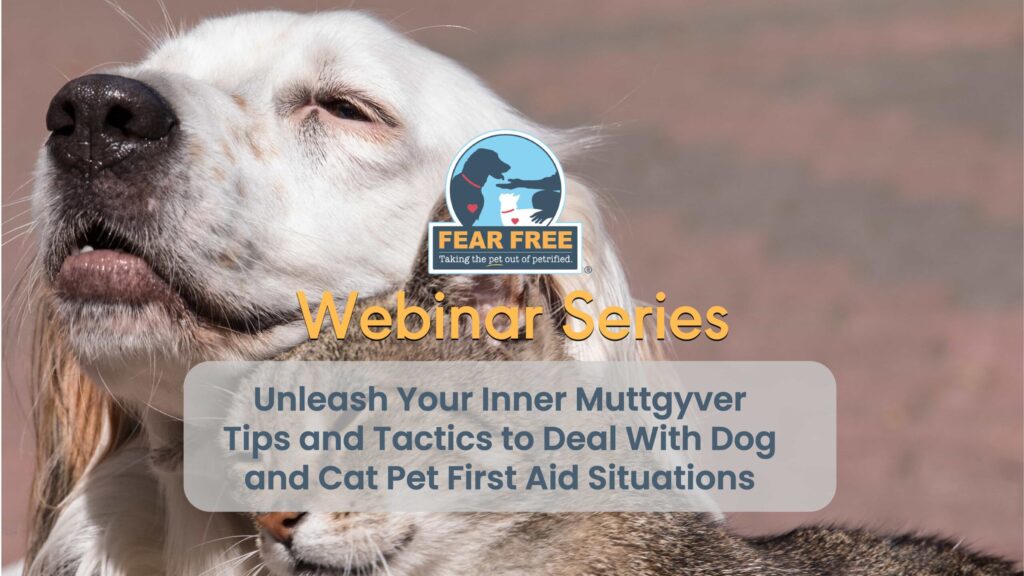
Unleash Your Inner Muttgyver: Tips and Tactics to Deal With Dog and Cat Pet First Aid Situations
In this recorded webinar, join health and safety coach Arden Moore as she demonstrates first aid on Pet Safety Dog Kona and Pet Safety Cat Casey, unleashing new ways to safely render aid without a pet first aid kit handy and safely transport injured pets. Learn how to incorporate Fear Free techniques to combat fear, anxiety, and stress in injured pets and build a confident, can-do attitude in you.